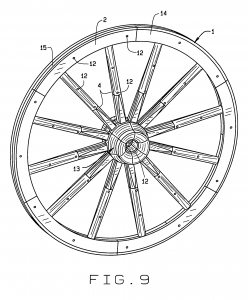Radiology Innovations
Radiology Innovations: Cumulative Impact

Wagon Wheel image from patent – Segmented wagon wheel design US 7536813 B2
“Imagine a Conestoga wagon wheel with Radiology at the hub with numerous subspecialties acting as spokes leading to every service line, such as neurology, general surgery, ENT, internal medicine, and many more.,” explains Joe Hasapes, M.D., Chief of Radiology at Lyndon B. Johnson (LBJ) Hospital and assistant professor of Diagnostic and Interventional Imaging (DII) at McGovern Medical School at UTHealth.
Diagnostic and Interventional Imaging, commonly referred to as Radiology, is a specialty that utilizes radiographic two-dimensional and complex three-dimensional imaging and minimally invasive interventional techniques to diagnose and treat diseases including x-rays, CT scans, MRI, nuclear medicine and catheter guided tumor ablation. At LBJ Hospital, the DII (Radiology) Department provides numerous access points for the many service lines. Thus the wagon wheel analogy is apt. The physicians of the department not only provide imaging and interventional procedures but are responsible for improving quality, patient satisfaction and safety, reducing service costs and improving efficiency through quality improvement that impacts the entire hospital.
One example of cost savings recently implemented was accomplished by Rekha Krishnasarma, M.D., a fourth-year radiology resident with McGovern Medical School at UTHealth. She worked to reduce the cost of an arthrogram tray significantly by changing a few items typically utilized on the tray. An arthrogram uses x-rays or ultrasound images to inject mediation or aspirate fluid from a joint. The savings totaled an average of nearly $2,500 a month or almost $30,000 a year. Remarkably, this result demonstrates that a small change can result in significant direct cost savings that can be, for example, budgeted towards hiring additional staff. This additional staff would have far-reaching benefits including reduction of patient wait times and improved patient care at LBJ Hospital.
Another example of quality improvement is a collaborative project between Radiology and the Emergency Department to improve the time from physician order to disposition by decreasing bottlenecks through radiology. Susanna Spence, M.D., Assistant Chief of Radiology and assistant professor of Diagnostic and Interventional Imaging and Kunal Sharma, M.D., assistant professor of Emergency Medicine, focused on CT abdomen pelvis orders; the second most common exam performed at LBJ Hospital. By identifying key processes in which delays were greatest, and by working collaboratively with the abdominal imaging section to reduce the indications for oral contrast, CT turnaround times have improved significantly and approximately $36,000 a year in oral contrast savings were realized. This project is continuing into its next phase shortly.
Finally, Dr. Hasapes performed a study that specifically improved patient satisfaction. He reduced the scan times in ultrasound by implementing integrated scanner protocols, which increased patient throughput which decreased patient wait times and consequently increased patient satisfaction from 68% to 80%.
These are just three specific innovation initiatives that have had a significant cumulative impact on patient care and satisfaction at LBJ Hospital. Multiple other innovations are underway by faculty and residents and are too numerous to discuss in detail but showcase the staff’s drive to continuously find ways to innovate and improve.
“I am constantly impressed by the quality initiatives of the radiology faculty working with the radiology staff and their willingness to be part of a successful team approach,” Dr. Hasapes said.
Improving patient care and reducing or avoiding costs is impactful. Dr. Hasapes and his colleagues the staff at LBJ Hospital realize they care for a large underserved population, and this scenario serves to motivate them to improve the quality of care while decreasing direct costs and is tantamount to their mission.